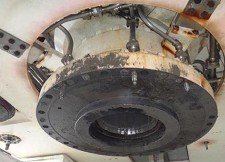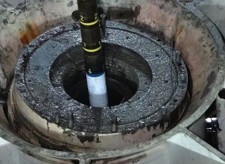10/7/2014 12:02:00 AM
HEADLINES
PERSPECTIVE: Fastener Experts Respond to Hydrogen Embrittlement Claim
Upper half of a failed lower marine riser package connector (photo: Bureau of Safety and Environmental Enforcement)
![]()
Lower half of a failed lower marine riser package connector (photo: Bureau of Safety and Environmental Enforcement)
On December 18, 2012, a Chevron offshore oil rig’s lower marine riser package separated from the blowout preventer, releasing approximately 432 barrels of synthetic-based drilling fluids into the Gulf of Mexico.
Chevron told the Bureau of Safety and Environmental Enforcement (BSEE) that the incident was the result of the failure of H4 connector bolts manufactured by GE Oil and Gas (formerly Vetco-Gray).
Based on the initial failure analysis, GE sent replacement bolts for all known H4 connectors to customers worldwide.
The root cause of the 2012 disconnect was hydrogen-induced stress corrosion cracking (HiSCC), a finding verified in a BSEE report dated August 2014.
The occurrence of HiSCC is consistent with the facts in the case, fastener experts Joe Greenslade and Salim Brahimi told FIN.
“On the other hand, there are inconsistencies in how the report defines HiSCC as the cause of the failures,” Greenslade and Brahimi noted in a joint statement to FIN.
First, HiSCC is the failure mechanism and must not be mistaken for root cause. Second, the term hydrogen induced stress corrosion cracking (HiSCC) applies when corrosion-generated hydrogen is the principal source of hydrogen. HiSCC is a subcategory of environmental hydrogen embrittlement (EHE); EHE is differentiated from internal hydrogen embrittlement (IHE) where the source of hydrogen is from manufacturing processes, notably from electroplating.
“The report apparently interchanges the two categories of hydrogen embrittlement. These fundamental misinterpretations, in conjunction with an investigation that stopped short of determining the true root cause of bolt failures, have led to a number of inaccurate conclusions.”
The BSEE report does not sufficiently emphasize a condition that is at the heart of the failures, notably the use of a pure zinc coating on high tension fasteners in sub-sea service, Greenslade and Brahimi stated. Zinc coatings are sacrificial with respect to steel and are used to cathodically protect steel components such as fasteners. The cathodic protection offered by zinc on steel is beneficial towards extending the corrosion life of a component.
On the other hand, the galvanic reactions that occur during this process result in hydrogen being absorbed by the steel in quantities that are orders of magnitude greater than if no coating is present.
“This source of hydrogen being absorbed by the fastener while it is under stress is much more significant and damaging than any amount hydrogen that remained in the part after electroplating,” Greenslade and Brahimi concluded.
The use of cathodic protection systems may have exacerbated these conditions of in-service hydrogen generation. High concentrations of hydrogen being locally absorbed by the fastener can lead to HiSCC failure provided two other conditions are also present: (i) fastener material that is inherently susceptible to hydrogen damage, and (ii) sufficiently high stress.
The question of conformance to the electroplating standard ASTM B633-98 is a “red herring” because ASTM B633 is not applicable to fasteners.
“Research and decades of practical experience have incontrovertibly shown that correctly manufactured fasteners with a specified hardness below 39 HRC are not susceptible to IHE.”
Otherwise stated, the concentration of hydrogen absorbed during zinc electroplating is not sufficiently high to cause hydrogen embrittlement of fasteners with a specified hardness below 39 HRC. In 1998, ASTM Committee F16 on Fasteners completed a three year process of developing and adopting ASTM F1941, “Standard Specification for Electrodeposited Coatings on Threaded Fasteners.” This standard was specifically developed by fastener and electroplating experts for the proper electrodepositing of metallic coatings, including zinc, on threaded mechanical fasteners. Prior to the publication of ASTM F1941, the only ASTM specification available for zinc electroplating of fasteners was ASTM B633, which is a general zinc electroplating standard (i.e., used for any type of hardware and not specific to fasteners). ASTM B633 is under the jurisdiction of ASTM Committee B08 on Inorganic Coatings, which operates independently from committee F16 on Fasteners. In the drafting of ASTM F1941 key topics addressed were avoidance of internal hydrogen embrittlement (IHE) and baking require-ments specific to fastener products. Most notably, ASTM F1941 adopts the industry practice of only mandating baking at specified hardness above 39 HRC.
To address the inconsistency in baking requirements between the two standards, the latest revision of ASTM B633-13 includes a sentence in the scope that emphasizes that the standard “may be used for fasteners but specific specifications have been developed for manufacturing fasteners in Committee F16 which may be more applicable (See Specification F1941/F1941M).”
“The decision to add a statement that does not categorically exclude fasteners was designed to accommodate the reality that ASTM B633 remains a legacy standard that is still occasionally referenced.”
However, in its current form, B633 is simply not applicable to fasteners because it mandates baking for all parts with hardness above 31 HRC. This requirement deviates from long established fastener industry practice and is the consequence of a change that was made by Committee B08 in 2007.
“More precisely, the tensile strength above which baking becomes mandatory is now 1,000 MPa (~31 HRC), reduced from 1,200 MPa (~39 HRC). The change was apparently made without consideration for consequences on the fastener industry and furthermore, there no evidence to warrant such a change. One of the consequences of the change is that fasteners that were electroplated to B633 in the years following 2007 suddenly became ‘non-conforming,’ not because they were faulty, but because a significant requirement in B633 had changed without notice to the industry.”
Given the unsuitability of zinc electroplating for sub-sea applications, the corrective action undertaken by GE and others to replace zinc electroplated fasteners with phosphate and oil coated bolts is appropriate because it effectively eliminates cathodic-corrosion generated hydrogen as a significant contributing factor.
“It is important to consider that GE used phosphate and oil coated bolts for many years without ever encountering failures of the type discussed in the BSEEE report. The bolt failures occurred only after the finish was changed to zinc.”
“Going forward, there is no doubt that the confusion resulting from these failures warrants the oil and gas industry reviewing fastener and bolting standards and practices it should adopt,” Greenslade and Brahimi concluded. “Any initiative to address the broader issues of fastener and bolting standards for the oil and gas applications must be undertaken as a collaborative effort between all stakeholders.”
“The body that is best suited to lead such an initiative is ASTM Committee F16 on Fasteners in conjunction with other affected ASTM Committees.”
Joe Greenslade is director of engineering technology at the Industrial Fasteners Institute. Email: jgreenslade@indfast.org
Salim Brahimi, president of IBECA Technologies, is a licensed member of the Quebec Order of Professional Engineers. Email: salim.brahimi@ibeca.ca



Share: